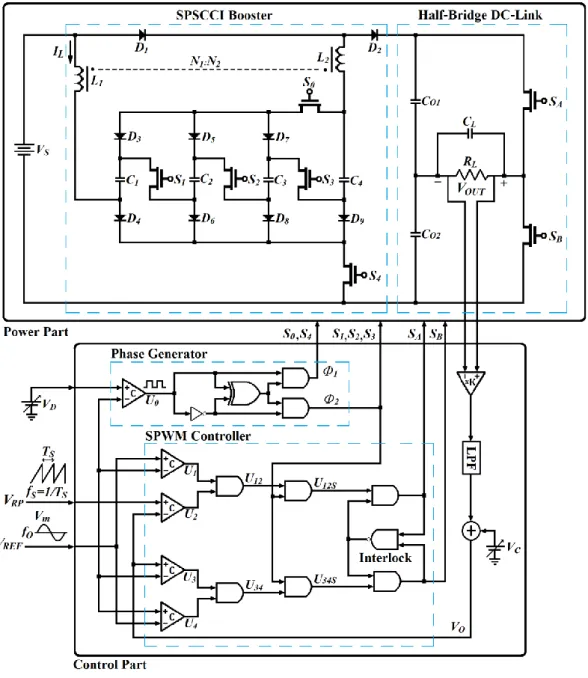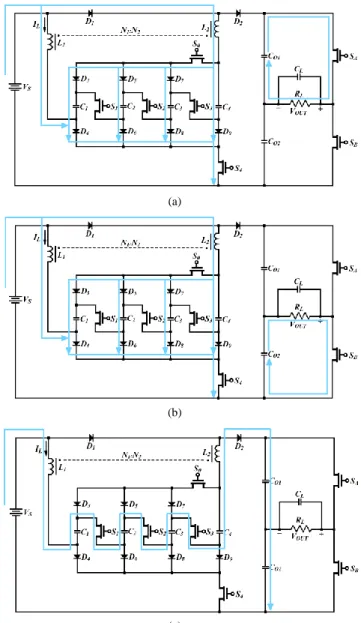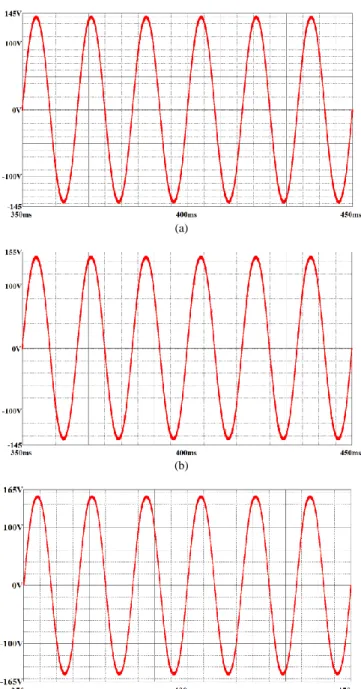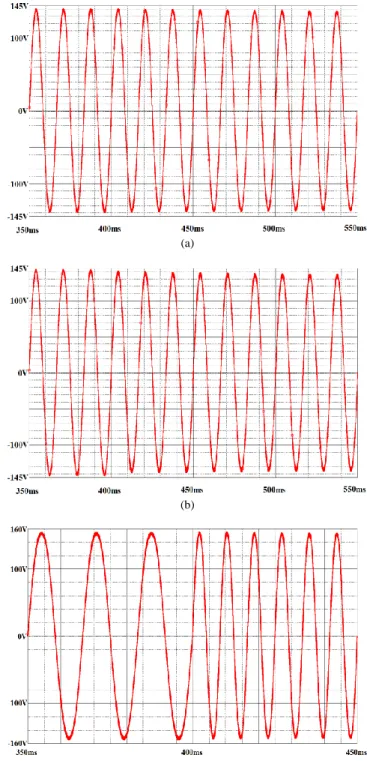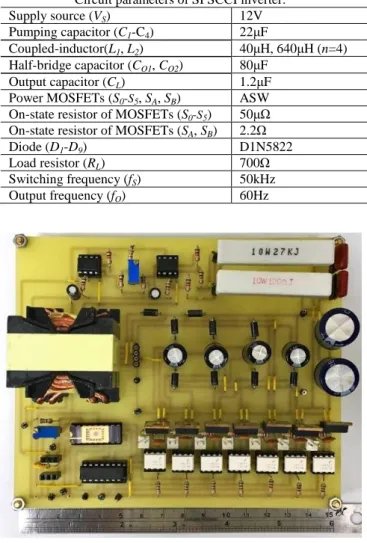Abstract—A closed-loop scheme of a high-gain serial- parallel-switched-capacitor coupled-inductor (SPSCCI) boost DC-AC inverter is proposed by combining a two-phase generator and sinusoidal pulse-width-modulation (SPWM) controller for low-power step-up DC-AC conversion and regulation. In this inverter, the power part is composed of SPSCCI booster and half-bridge DC-link. This booster is a 4-stage SC circuit plus combining a coupled-inductor, and it raises the voltage gain up to [4(n+1)+(1+nD)/(1-D)] at most via two-phase operation, where D is the duty cycle and n is the turn ratio of coupled-inductor. The DC-link is a half-bridge circuit in order to convert the DC voltage into AC via SPWM control for realizing the range of sinusoidal output:
+0.5[4(n+1)+(1+nD)/(1-D)]VS~ -0.5[4(n+1)+(1+nD)/(1-D)]VS. Practically, the maximum output voltage can reach 26.0 times voltage of source VS while D=0.5, n=4. Here, the SPWM is employed to enhance regulation capability for the different output amplitude and frequency, as well as robustness to source/loading variation. Finally, the closed-loop SPSCCI inverter is designed and simulated by SPICE for some cases:
steady-state and dynamic responses. All results are illustrated to show the efficacy of the proposed scheme.
Index Terms—serial-parallel-switched-capacitor, coupled- inductor, high-gain boost, DC-AC inverter, sinusoidal pulse- width-modulation.
I. INTRODUCTION
ecently, high-gain step-up power converters are widely used as power modules between the available low- voltage sources and the output loads, such as lighting device, smart phone, and medical equipment ...etc. These modules are always asked for some good characteristics: small volume, light weight, higher efficiency, and better regulation capability. Generally, the traditional converters have a large volume and a heavy weight due to magnetic elements.
Therefore, more manufactures and researchers pay much attention to this topic, and ultimately, requiring DC-DC/
DC-AC step-up converters realized on a compact chip by mixed-mode VLSI technology.
This kind of switched-capacitor (SC) power converters, containing only capacitors and MOSFET switches, is one of the good solutions to provide the higher voltage gain for
Manuscript received December 1, 2016. This work is supported in part by Ministry of Science and Technology of Taiwan, R.O.C., under Grant MOST 105-2221-E-324-011.
Yuen-Haw Chang and Zheng-Bin Li are with the Department and Graduate Institute of Computer Science and Information Engineering, Chaoyang University of Technology, Taichung, Taiwan, R.O.C. Post code:
413. (e-mail: cyhfyc@cyut.edu.tw, s10427606@gm.cyut.edu.tw).
realizing the boost DC-DC/DC-AC conversion in the non- magnetic circuit. Up to now, the various SC types have been suggested. In 1976, Dickson charge pumping was proposed based on a diode-chain structure via pumping capacitors [1].
In 1990s, Ioinovici proposed a SC with two capacitor cells working complementarily, as well as current-mode SC [2-3].
In 2007, Chang proposed a CPLD-based implementation of SC step-down DC-DC converter for multiple output choices [4]. In 2011-2013, Chang et al. proposed a series of multistage/multiphase SC step-up/down DC-DC/DC-AC converter/inverter [5-8]. In 2014, Chang et al. proposed a 2-stage 4-phase SC-based boost DC-AC inverter with sinusoidal PFM control [9]. In 2015, Chang et al. proposed a closed-loop high-gain switched-capacitor-inductor-based boost DC-AC inverter [10].
To obtain a higher voltage gain, it is one of the good ways by using the turn ratio and/or extra winding stage of the coupled-inductor. Nevertheless, the stress on transistors and the volume of magnetic device must be considered. In 2015, Chen et al. proposed a coupled-inductor boost integrated flyback converter including high-voltage gain and ripple-free input current [11]. Bahrami et al. suggested a modified step-up boost converter with coupled-inductor and super-lift techniques [12]. Chen et al. proposed a novel switched- coupled-inductor DC-DC step-up converter and its derivatives [13]. Wu et al. proposed a nonisolated high step-up DC-DC converter adopting switched-capacitor cell [14]. Nouri et al. proposed an interleaved high-gain step-up DC-DC converter based on three-winding high-frequency coupled-inductor and voltage-multiplier cell [15]. In 2016, Chang et al. proposed a novel coupled-inductor switched- capacitor inverter for high-gain boost DC-AC conversion [16]. Here, the authors make an attempt on combining 4-stage SC circuit with one coupled-inductor to propose a closed- loop SPSCCI inverter for the high-gain DC-AC conversion and regulation.
II. CONFIGURATION OF SPSCCIINVERTER
Fig. 1 shows the high-gain serial-parallel-switched- capacitor coupled-inductor (SPSCCI) inverter proposed, and it contains two major parts: power and control part achieving the boost DC-AC conversion and closed-loop regulation.
These two parts are discussed as follows.
A. Power Part
The power part of this inverter as in the upper half of Fig. 1 contains a SPSCCI booster and a half-bridge DC-link in cascaded connection between supply VS and output VOUT .
A High-Gain Serial-Parallel-
Switched-Capacitor Coupled-Inductor Boost DC-AC Inverter
Yuen-Haw Chang and Zheng-Bin Li
R
Firstly, the SPSCCI booster is a 4-stage SC circuit plus combining a coupled-inductor. It includes switches S0, S1, S2, S3, and S4, diodes D1-D9, coupled-inductors L1, L2, pumping capacitors C1, C2, C3, and C4, where it is assumed that same capacitance C (C1=C2=C3=C4=C). The coupled-inductor L1
and L2 is modeled as an ideal transformer with a turn ratio of n (n=N2/N1). The main function of this booster is to raise the voltage gain up to [4(n+1)+(1+nD)/(1-D)] at most from supply VS to half-bridge total capacitor voltage (VCO1+VCO2), where D (0<D<1) is the duty cycle and DTS is the period of charging coupled-inductor in a switching cycle TS (TS=1/fS, fS is the switching frequency). Secondly, the half-bridge DC- link circuit is composed of switches SA, SB, half-bridge capacitor CO1, CO2, and filter capacitor CL in aim for the DC- AC conversion to supply the load RL, where CO1, CO2 are assumed with the same capacitance (CO1=CO2=CO). With the help of SA and SB in the half-bridge, the maximum range of the AC output VOUT can reach: +0.5[4(n+1)+(1+nD)/(1-D)]VS~ -0.5[4(n+1)+(1+nD)/(1-D)]VS. Fig. 2 shows the theoretical waveforms within an output cycle TO (TO=1/fO, fO is the output frequency). Here, for the convenience of explanation, an output cycle TO contains 11 (or above actually) switching
cycle TS. Each TS has two phase: Phase I and II with the different periods DTS and (1-D)TS. The detailed operations are discussed as follows.
1) Phase I:
During this time interval, turn on S0, S4 and turn off S1, S2, S3. Then, the diodes D1, D3-D9 are turned on, and D2 is off. The inductor L1 is charged by supply VS, and simultaneously the energy is transferred from the first side of the coupled-inductor to the secondary side, then the voltage of VL1=+VS, VL2=-nVS. The pumping capacitors C1-C4 are charged in parallel by supply VS together with VL2 so as to make VC1, VC2, VC3, VC4 reaching the value of (n+1)VS. At the same time, CO1 or CO2 is operating as follows. While SA is ON, the relevant topology is shown in Fig. 3(a). CO1 is discharged to supply the energy to CL
and RL towards the positive output. While SB is ON, the relevant topology is shown in Fig. 3(b). CO2 is discharged to supply the energy to CL and RL, towards the negative output.
Fig. 1. Configuration of SPSCCI inverter.
Fig. 2. Theoretical waveforms of SPSCCI Inverter.
(a)
(b)
(c)
Fig. 3. Topologies for Phase (a) I (SA:ON), (b) I (SB:ON), and (b) II.
2) Phase II:
During this time interval, turn on S1, S2, S3, and turn off S0, S4. Then, the diodes D1, D3-D9 are turned off, and D2 is on. The relevant topology is shown in Fig. 3(c).
According to the theory of the booster, the steady-state voltage VL1 across L1 is going towards the value of -DVS/(1-D) via the operation of duty cycle D, and thus the voltage VL2 across L2 in the secondary side is approaching the value of +nDVS/(1-D). Based on the current path as in Fig. 3(c), the half-bridge total capacitor voltage (VCO1+VCO2) can be charged by VS, VL1, VC1, VC2, VC3, VC4, and VL2 in series connection (i.e. VS+ VL1+VC1+VC2+VC3+VC4+VL2→VCO1+VCO2). Hence, the steady-state voltage of VCO1+VCO2 will be boosted into [4(n+1)+(1+nD)/(1-D)]VS.
Based on the cyclical operations of Phase I and II, the overall step-up gain can reach the value of [4(n+1)+
(1+nD)/(1-D)] theoretically (from VS to half-bridge total capacitor voltage). Extending the capacitor count, the gain can be [m(n+1)+(1+nD)/(1-D)], where m is the number of pumping capacitors. Further, with the help of the half-bridge DC-link, the AC output can be realized for the range of +0.5[m(n+1)+(1+nD)/(1-D)]VS~ -0.5[m(n+1)+(1+nD)/(1-D)]VS.
B. Control Part
The control part of SPSCCI inverter is composed of a two-phase generator and a SPWM controller as in the lower half of Fig. 1. The operations of these two blocks are discussed as follows. Firstly, an adjustable voltage VD is compared with a ramp function VRP to produce a non- symmetrical clock signal U0. And then, this clock is sent to the non-overlapping circuit so as to obtain a set of phase signals Φ1 and Φ2 for the driver signals of and S0, S4 and S1-S3. Thus, D is exactly the on-time ratio (duty cycle) of S0, S4, and DTS (period of Phase I) can be regulated by the value of VD. The main goal is to generate the driver signals of switches for the different topologies.
Secondly, from the controller signal flow, the output voltage VOUT is attenuated and fed back into the OP-amp low-pass filter (LPF) for high-frequency noise rejection.
Next, by using a further DC-shift of VC, VO is obtained and compared with the desired output VREF via 4 comparators U1, U2, U3 and U4, and following by using logic-AND to produce a set of control signals U12, U34 for realizing SPWM. When e>0 and |e| is raising (e=VREF -VO), the pulse width of U12 is getting bigger. When e<0 and |e| is raising, the pulse width of U34 is getting bigger. And then, via the interlock circuit (avoid SA and SB being 1 simultaneously) plus coming into the phase of Φ2, SA and SB can be obtained for the SPWM control.
The main goal is to keep VO on following VREF (sinusoidal reference) to enhance the regulation capability of this proposed inverter. To summarize, based on VO and VREF, the relevant rules of producing the control/driver signals are listed as below.
1) Φ1, Φ2: non-overlapping anti-phase signals from U0; S0=Φ1; S4=Φ1;
S1=Φ2; S2=Φ2; S3=Φ2;
2) If VD>VRP, then U0=1; If VD<VRP, then U0=0.
3) If VREF>VRP, then U1=1; If VREF<VRP, then U1=0;
If VRP >VO, then U2=1; If VRP<VO, then U2=0;
If VO >VRP, then U3=1; If VO<VRP, then U3=0;
If VREF>VRP, then U4=1; If VREF<VRP, then U4=0;
4) If U1=1 and U2=1, then U12=1 (otherwise U12=0);
If U3=1 and U4=1, then U34=1 (otherwise U34=0);
5) If U12=1 and Φ2=1, then U12S=1 (else U12S=0);
If U34=1 and Φ2=1, then U34S=1 (else U34S=0);
6) SPWM control signals: (^: logic-AND) SA= U12S ^Φ2, for VREF >VO;
SB= U34S ^Φ2, for VREF<VO.
III. EXAMPLES OF SPSCCIINVERTER
In this paper, the proposed SPSCCI is simulated by SPICE, and all the parameters are listed in TABLE I. There are totally 3 cases for steady-state responses and 4 cases for dynamic responses respectively. Then, these results are illustrated to verify the efficacy of the proposed inverter.
(a)
(b)
(c)
Fig. 4. Output VOUT for VREF: (a) fO =60Hz, Vm =145V; (b) fO=60Hz, Vm=155V; (c) fO =60Hz, Vm=165V.
1) Steady-State Responses:
Case 1: fO=60 Hz, Vm=145V
Let the supply source VS be DC 12V, load RL be 700Ω, and the peak value and output frequency of VREF are Vm=145V, fO=60Hz. The waveform of VOUT is obtained as in Fig. 4(a). VOUT has the practical peak value of 141V (i.e. 99.7VRMS), and the practical output frequency is about 60Hz. The efficiency is 67.3% and THD is 2.298%.
Case 2: fO=60 Hz, Vm=155V
Let the supply source VS be DC 12V, load RL be 700Ω, and the peak value and output frequency of VREF are Vm=155V, fO=60Hz. The waveform of VOUT is obtained as in Fig. 4(b). VOUT has the practical peak value of 148V (i.e. 104.7VRMS), and the practical output frequency is about 60Hz. The efficiency is 70.1% and THD is 2.693%.
Case 3: fO=60 Hz, Vm=165V
Let the supply source VS be DC 12V, load RL be 700Ω, and the peak value and output frequency of VREF are Vm=165V, fO=60Hz. The waveform of VOUT is obtained as in Fig. 4(c). VOUT has the practical peak value of 158V (i.e. 111.7VRMS), and the practical output frequency is about 60Hz. The efficiency is 71.3% and THD is 3.799%.
2) Dynamic Responses:
Since the voltage of battery is getting low as the battery is working long time, or the bad quality of battery results in the impurity of source voltage, such a variation of source voltage VS must be considered, as well as variation of load RL and/or reference VREF (fO or Vm).
Case 1: VS variation
Assume that VS is normally at DC 12V, and then it has an instant voltage jump of 12V →11V on 400ms (VREF: fO=60Hz, Vm=145V). The waveform of VOUT is shown as in Fig. 5(a). Obviously, VOUT has a slight decrease into about 138V.
Case 2: RL variation
Assume that RL is 1kΩ normally, and it suddenly changes from 1kΩ to 0.5kΩ on 400ms (VREF: fO= 60Hz, Vm=145V). Fig. 5(b) shows the transient waveform of VOUT at the moment of loading variation. Obviously, VOUT has a small drop but can still be following VREF.
Case 3: fO variation
Assume that the frequency fO of VREF is 60Hz normally. After a period of 400ms, and it suddenly changes from 60Hz to 120Hz. Fig. 5(c) shows the transient waveform of VOUT at the moment of variation: fO =60Hz→120Hz (Vm=165V). Obviously, VOUT is still able to follow VREF even the frequency of VREF changes.
Case 4: Vm variation
Assume that Vm is 165V normally, After a period of 400ms, and it changes from 165V to 145V. Fig.
5(d) shows the transient waveform of VOUT at the moment of variation: Vm=165V→145V. Obviously, VOUT is still able to follow VREF even the amplitude of the desired VREF changes.
According to the above results, it is obvious that VOUT is following VREF for the cases, including VS source variation, RL loading variation, fO frequency variation, Vm amplitude variation. These results show that this proposed inverter has a good closed-loop dynamic performance.
(a)
(b)
(c)
(d)
Fig. 5. Output VOUT for the variation of (a) VS; (b) RL; (c) fO; (d) Vm.
TABLEI
Circuit parameters of SPSCCI inverter.
Supply source (VS) 12V
Pumping capacitor (C1-C4) 22μF
Coupled-inductor(L1, L2) 40μH, 640μH (n=4) Half-bridge capacitor (CO1, CO2) 80μF
Output capacitor (CL) 1.2μF Power MOSFETs (S0-S5, SA, SB) ASW On-state resistor of MOSFETs (S0-S5) 50μΩ On-state resistor of MOSFETs (SA, SB) 2.2Ω
Diode (D1-D9) D1N5822
Load resistor (RL) 700Ω
Switching frequency (fS) 50kHz Output frequency (fO) 60Hz
Fig. 6. Prototype circuit of SPSCCI inverter.
IV. CONCLUSION
A closed-loop scheme of a high-gain SPSCCI boost DC- AC inverter is proposed by combining a two-phase generator and SPWM controller for low-power step-up DC-AC conversion and regulation (SPSCCI: DC VS → AC VOUT: +0.5[m(n+1)+(1+nD)/(1-D)]VS~ -0.5[m(n+1)+(1+nD)/(1-D)]VS ).
Finally, the closed-loop SPSCCI inverter is designed and simulated by SPICE for some cases: steady-state and dynamic responses. The advantages of the proposed scheme are listed as follows. (i) This SPSCCI needs just one coupled- inductor element (inductor). Except this, other components (i.e. SC) will be able to be made in IC fabrication future. (ii) This proposed inverter can provide a high voltage gain (from VS to half-bridge total capacitor voltage) of [4(n+1)+(1+nD)/(1-D)]
at most. (iii) For a higher gain, it can be realized with increasing the turn ratio of coupled-inductor or extending the number of pumping capacitors. (iv) The SPWM technique is adopted not only to enhance output regulation capability for the different desired output, but also to reinforce the output robustness against source/loading variation. At present, the prototype circuit of this inverter is implemented in the laboratory as shown in the photo of Fig. 6. Some experimental results will be obtained and measured for the verification of the proposed inverter.
REFERENCES
[1] John F. Dickson, “On-chip high-voltage generation in MNOS integrated circuits using an improved voltage multiplier technique,”
IEEE Journal of Solid-State Circuits, vol. 11, no. 3, pp. 374-378, Jun.
1976.
[2] On-Cheong Mak, Yue-Chung Wong and Adrian Ioinovici, “Step-up DC power supply based on a switched-capacitor circuit,” IEEE Transactions on Industrial Electronics, vol. 42, no. 1, pp. 90-97, Feb.
1995.
[3] Guangyong Zhu and Adrian Ioinovici, “Steady-state characteristics of switched-capacitor electronic converters,” Journal of Circuits, Systems and Computers, vol. 7 , no. 2, pp. 69-91, 1997.
[4] Yuen-Haw Chang, “CPLD-based closed-loop implementation of switched-capacitor step-down DC-DC converter for multiple output choices,” IET Electric Power Applications, vol. 1, issue 6, pp. 926-935, Nov. 2007.
[5] Yuen-Haw Chang, “Design and analysis of multistage multiphase switched-capacitor boost DC-AC inverter,” IEEE Transactions on Circuits and Systems I: Regular paper, vol. 58, no. 1, pp. 205-218, Jan.
2011.
[6] Yuen-Haw Chang, “Variable-conversion-ratio multistage switched- capacitor-voltage-multiplier/divider DC-DC converter,” IEEE Transactions on Circuits and Systems I: Regular paper, vol. 58, no. 8, pp. 1944-1957, Aug. 2011.
[7] Yuen-Haw Chang and Ming-Zong Wu, “Generalized mc x nc -stage switched-capacitor-voltage-multiplier-based boost DC-AC inverter,”
International Journal of Electronics, vol. 99, no. 1, pp. 29-53, Jan.
2012.
[8] Yuen-Haw Chang and Yun-Jie Huang, “Closed-loop 7-Level switched-capacitor boost DC-AC inverter with sinusoidal PFM control,” International MultiConference of Engineers and Computer Scientists 2013 (IMECS'2013), vol. 2, Hong Kong, pp. 641-646, Mar.
13-15, 2013.
[9] Yuen-Haw Chang, Chin-Ling Chen and Po-Chien Lo, “2-Stage 4-Phase Switched-Capacitor Boost DC-AC Inverter with Sinusoidal PFM Control,” International MultiConference of Engineers and Computer Scientists 2014 (IMECS'2014), vol. 2, Hong Kong, pp.
673-678, Mar. 12-14, 2014.
[10] Yuen-Haw Chang, Yu-Kai Lin, “A closed-loop high-gain switched- capacitor-inductor-based boost DC-AC inverter,” International MultiConference of Engineers and Computer Scientists 2015 (IMECS'2015), vol. 2, Hong Kong, pp. 694-699, Mar. 18-20, 2015.
[11] Zhangyong Chen, Qun Zhou and Jianping Xu, “Coupled-inductor boost integrated flyback converter with high-voltage gain and ripple- free input current,” IET power Electronics, vol. 8, pp. 213-220, Feb.
2015.
[12] Hamid Bahrami, Hossein Iman-Eini, Babak Kazemi, Alireza Taheri,
“Modified step-up boost converter with coupled-inductor and super-lift techniques,” IET power Electronics, vol. 8, pp. 898-905, Jun. 2015.
[13] Shih-Ming Chen, Man-Long Lao, Yi-Hsun Hsieh, Tsorng-Juu Liang, Kai-Hui Chen, “A novel switched-coupled-inductor DC-DC step-up converter and its derivatives,” IEEE Transactions on Industry Applications, vol. 51, no. 1, pp. 309-314, Jan. 2015.
[14] Gang Wu, Xinbo Ruan, Zhihong Ye, “Nonisolated high step-up DC-DC converters adopting switched-capacitor cell,” IEEE Transactions on Industrial Electronics, vol. 32, no. 1, pp. 383-393, Jan.
2015.
[15] Tohid Nouri, Seyed Hossein Hosseini, Ebrahim Babaei and Jaber Ebrahimi, “Interleaved high step-up DC-DC converter based on three-winding high-frequency coupled inductor and voltage multiplier cell,” IET Power Electronics, vol. 8, no. 2, pp. 175-189, Feb. 2015.
[16] Yuen-Haw Chang, Jyun-Jia Liao, “A novel coupled-inductor switched- capacitor inverter for high-gain boost DC-AC conversion,”
International MultiConference of Engineers and Computer Scientists 2016 (IMECS'2016), vol. 2, Hong Kong, pp. 603-608, Mar. 16-18, 2016.
